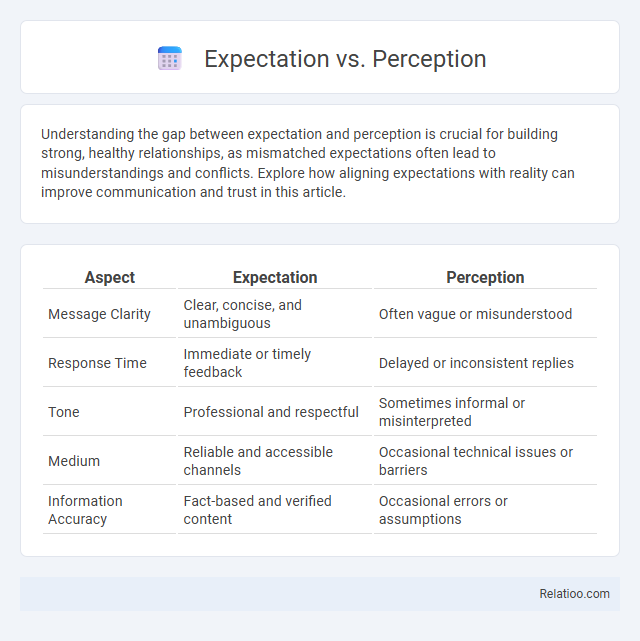Understanding the gap between expectation and perception is crucial for building strong, healthy relationships, as mismatched expectations often lead to misunderstandings and conflicts. Explore how aligning expectations with reality can improve communication and trust in this article.
Table of Comparison
| Aspect | Expectation | Perception |
|---|---|---|
| Message Clarity | Clear, concise, and unambiguous | Often vague or misunderstood |
| Response Time | Immediate or timely feedback | Delayed or inconsistent replies |
| Tone | Professional and respectful | Sometimes informal or misinterpreted |
| Medium | Reliable and accessible channels | Occasional technical issues or barriers |
| Information Accuracy | Fact-based and verified content | Occasional errors or assumptions |
Introduction: Defining Expectation and Perception
Expectation represents an individual's anticipatory beliefs about future events based on prior knowledge or experiences, while perception involves the process of interpreting sensory information to form an understanding of the present reality. These cognitive constructs influence decision-making and behavior by shaping how reality is anticipated and subsequently experienced. Understanding the distinction between expectation and perception is crucial for analyzing discrepancies in human judgment and behavior.
The Psychology Behind Expectations
Expectations are mental predictions about future events shaped by prior experiences, while perceptions refer to the real-time interpretations of sensory information. The psychology behind expectations reveals they influence how Your brain processes and interprets events, creating a filter that shapes reality. Misalignment between expectation and perception can lead to cognitive dissonance or satisfaction, impacting emotional responses and decision-making.
How Perceptions Are Formed
Perceptions are formed through the interaction of sensory input and cognitive processes, where your brain interprets data based on prior experiences, cultural background, and contextual cues. Expectations create a mental framework that influences how information is processed, often leading to biases or selective attention that shape perception. Understanding this dynamic helps you recognize the gap between expectation and reality, improving decision-making and communication.
The Gap Between Expectation and Reality
The gap between expectation and reality arises when your perceived experience fails to meet anticipated standards, often leading to dissatisfaction. Businesses measure this disparity using models like the SERVQUAL gap, which highlights variances in service delivery versus customer expectations. Bridging this gap through consistent communication and quality improvement enhances customer satisfaction and loyalty.
Factors Influencing Expectations
Factors influencing expectations include past experiences, cultural background, and individual personality traits, which shape how You anticipate outcomes in various situations. External influences such as social norms, media portrayals, and peer opinions also play crucial roles in forming these expectations. Understanding these elements helps bridge the gap between expectation and perception, improving decision-making and satisfaction levels.
Cultural Impact on Perception
Cultural impact significantly shapes perception by influencing how individuals interpret sensory information and social cues based on their cultural background and experiences. Expectation, formed through cultural norms and values, sets a framework that affects your interpretation of events and behaviors, often leading to variations in perception across different cultures. Understanding the interplay between expectation and perception is crucial for navigating cross-cultural interactions effectively.
Real-World Examples of Expectation vs Perception
Expectation versus perception often diverges in customer experiences, as seen in the airline industry where passengers anticipate punctual flights but frequently perceive delays, affecting satisfaction scores. In retail, shoppers expect seamless checkout processes, yet technical glitches or long lines lead to a perception of inefficiency, influencing repeat business. Healthcare provides another example: patients expect quick appointments and clear communication, but perceived wait times and confusing medical jargon can negatively impact their overall experience.
Consequences of Mismatched Expectations and Perceptions
Mismatched expectations and perceptions can lead to decreased customer satisfaction, eroding brand loyalty and increasing churn rates. When Your customers' perceived service falls short of their initial expectations, it creates a trust gap that negatively impacts long-term engagement and revenue. Addressing these discrepancies promptly enhances customer experience and strengthens competitive advantage.
Strategies to Align Expectations with Perceptions
Strategies to align expectations with perceptions include clear communication of service standards and consistent delivery of promised experiences to bridge the gap between what customers anticipate and what they actually encounter. Implementing feedback mechanisms and real-time monitoring helps identify discrepancies early, enabling proactive adjustments that refine service quality and enhance satisfaction. Training employees to understand and manage customer expectations ensures a cohesive approach that aligns perceptions with organizational commitments.
Conclusion: Bridging the Expectation-Perception Divide
Bridging the expectation-perception divide requires aligning your service delivery with customer expectations through continuous feedback and adaptive strategies. Employing tools like surveys and real-time analytics helps identify gaps, enabling precise adjustments that enhance satisfaction. Focusing on transparent communication and proactive issue resolution ultimately transforms expectations into positive perceptions, strengthening trust and loyalty.

Infographic: Expectation vs Perception
 relatioo.com
relatioo.com